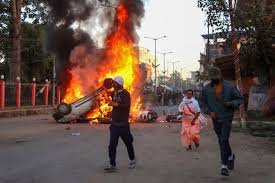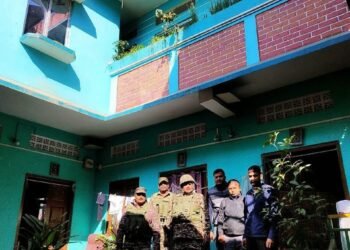Despite a high-voltage padyatra across Bihar, the party secured just 3.44% votes, finishing second in only one seat and trailing far behind established political players.
By PC Bureau
November 16: The Prashant Kishor–led Jan Suraaj Party has recorded a dramatic failure in the Bihar Assembly elections, ending a three-year political experiment with no seats, just 18 lakh votes, and lost deposits in 236 of the 238 constituencies it contested.
For a party that had projected itself as Bihar’s next big political disruptor—fronted by one of India’s most prominent election strategists—the results have raised pointed questions about its strategy, timing, organisational depth and the limits of personality-driven politics.
A Loud Campaign, a Quiet Verdict
According to Election Commission data, Jan Suraaj finished second in only one seat, third in 126 seats, and fourth or below in the rest. Its statewide vote share of 3.44 percent failed to register meaningfully on Bihar’s political radar.
A constituency-level analysis shows that Kishor’s high-octane padyatra, meticulous cadre-building, and tech-forward campaigning did not translate into voter momentum. Even in seats where the party invested significantly, outcomes remained modest:
-
Chanpatia: 37,172 votes (3rd)
-
Jokihat: 35,354 votes (3rd)
-
Raghunathpur: 3,071 votes (3rd)
-
Atri: 3,177 votes (3rd)
Its best performance came from Marhaura, where it finished second with 58,190 votes—still far behind the RJD candidate, who secured 86,118.
READ: ‘Dirty Kidney’ Slur to Slipper Attack: Rohini Acharya’s Explosive Allegations Against Tejashwi
How Jan Suraaj Hurt the BJP in Tight Contests
Despite failing to win, Jan Suraaj influenced the results in a handful of closely fought seats, particularly impacting the BJP:
-
Dhaka: BJP lost by 178 votes; Jan Suraaj polled 8,347.
-
Ramgarh: BJP lost by 30 votes; Jan Suraaj secured 4,426.
These scattered but significant instances show Kishor’s outfit played spoiler in select constituencies—a far cry from the “kingmaker” image he once embraced.
NOTA Outperforms Jan Suraaj in 54 Seats
In one of the more striking trends, NOTA (None of the Above) polled more votes than Jan Suraaj in 54 constituencies, signalling widespread voter hesitation.
Examples include:
-
Pipra: NOTA 10,691 | JSP 5,519
-
Dhamdaha: NOTA 6,781 | JSP 1,804
-
Mahishi: NOTA 6,671 | JSP 2,571
-
Kanti: NOTA 7,823 | JSP 4,251
In four constituencies, NOTA edged ahead by razor-thin margins:
-
Ghosi: 3 votes
-
Barari: 21 votes
-
Kochadhaman: 63 votes
-
Gopalpur: 81 votes
The trend underscores voter reluctance to embrace a new political formation despite its high visibility.
A Debut Far Below Bihar’s Historical Benchmarks
Jan Suraaj’s vote share stands in stark contrast to the debut performances of Bihar’s dominant regional parties:
-
RJD (1997–2000): 28.34% vote share, 124 seats
-
JD(U) (2005): Over 25% vote share
The data suggests Bihar has historically rewarded formations rooted in caste coalitions or mass leadership—neither of which Jan Suraaj managed to cultivate.
Why Jan Suraaj Faltered: Four Structural Fault Lines
-
Kishor Did Not Contest
Kishor’s decision to stay out of the fray—despite repeatedly hinting he might challenge Tejashwi Yadav from Raghopur—damaged his credibility among voters. -
Absence of Community Anchoring
In a state where caste identity remains central, Jan Suraaj’s caste-neutral pitch left it without a committed vote base. -
Overdependence on Padyatra Politics
While Kishor’s 665-day foot march attracted attention, it lacked the on-ground organisational depth needed to convert visibility into votes. -
NDA’s Welfare Wave
The NDA’s pre-election ₹10,000 transfer to 1.3 crore women created a powerful surge of goodwill, consolidating undecided voters behind the ruling coalition.
The Broader Landscape: Reality vs Claims
Kishor had famously predicted that Jan Suraaj would win 150 seats and said he would quit politics if the JD(U) crossed 25 seats. The JD(U) went on to win 85 of the 101 seats it contested—more than triple the threshold Kishor had set for his exit.
He is expected to address the media in Patna on Sunday, with speculation rife over whether he will keep his word.
A Campaign That Delivered Visibility, Not Votes
According to Jan Suraaj’s own data:
-
665 days of padyatras
-
2,700 villages covered
-
1.06 crore members enlisted
-
Presence in all 38 districts
But despite the scale, the movement delivered recognition, not representation.
The message from Bihar’s electorate is unambiguous:
Breaking into a state defined by entrenched caste loyalties and long-standing political networks requires far more than a high-decibel, technocratic campaign.












